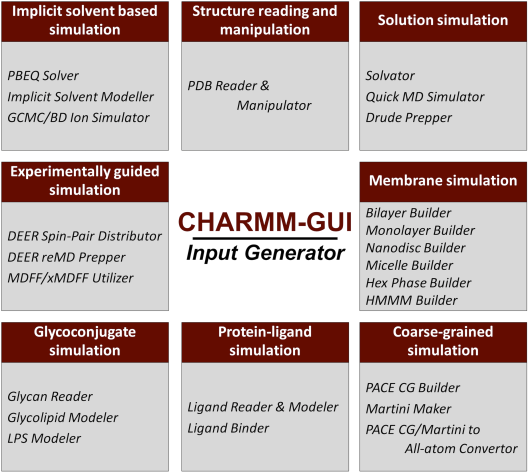CHARMM-GUI 10 years for biomolecular modeling and simulation
By Sunhwan Jo, Xi Cheng, Jumin Lee, Seonghoon Kim, Sang-Jun Park, Dhilon S. Patel, Andrew H. Beaven, Kyu Il Lee, Huan Rui, Soohyung Park, Hui Sun Lee, Benoı̂t Roux, Alexander D. MacKerell Jr, Jeffrey B. Klauda, Yifei Qi, Wonpil Im.
Published in J Comput Chem. 2017 Jun 5;38(15):1114-1124. PMID: 27862047. PMCID: PMC5403596. Link to Pubmed page.
Core Facility: Computational Modeling

Schematic view of modules in CHARMM-GUI Input Generator.
Abstract
CHARMM-GUI, http://www.charmm-gui.org, is a web-based graphical user interface that prepares complex biomolecular systems for molecular simulations. CHARMM-GUI creates input files for a number of programs including CHARMM, NAMD, GROMACS, AMBER, GENESIS, LAMMPS, Desmond, OpenMM, and CHARMM/OpenMM. Since its original development in 2006, CHARMM-GUI has been widely adopted for various purposes and now contains a number of different modules designed to set up a broad range of simulations: (1) PDB Reader & Manipulator, Glycan Reader, and Ligand Reader & Modeler for reading and modifying molecules; (2) Quick MD Simulator, Membrane Builder, Nanodisc Builder, HMMM Builder, Monolayer Builder, Micelle Builder, and Hex Phase Builder for building all-atom simulation systems in various environments; (3) PACE CG Builder and Martini Maker for building coarse-grained simulation systems; (4) DEER Facilitator and MDFF/xMDFF Utilizer for experimentally guided simulations; (5) Implicit Solvent Modeler, PBEQ-Solver, and GCMC/BD Ion Simulator for implicit solvent related calculations; (6) Ligand Binder for ligand solvation and binding free energy simulations; and (7) Drude Prepper for preparation of simulations with the CHARMM Drude polarizable force field. Recently, new modules have been integrated into CHARMM-GUI, such as Glycolipid Modeler for generation of various glycolipid structures, and LPS Modeler for generation of lipopolysaccharide structures from various Gram-negative bacteria. These new features together with existing modules are expected to facilitate advanced molecular modeling and simulation thereby leading to an improved understanding of the structure and dynamics of complex biomolecular systems. Here, we briefly review these capabilities and discuss potential future directions in the CHARMM-GUI development project. © 2016 Wiley Periodicals, Inc.


